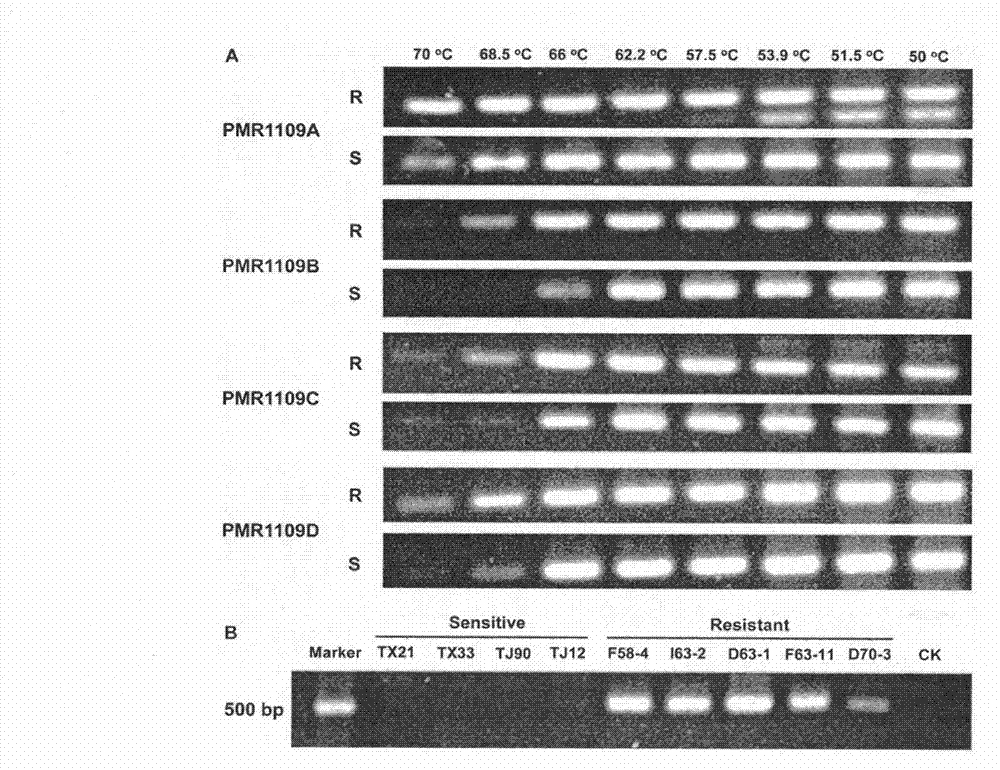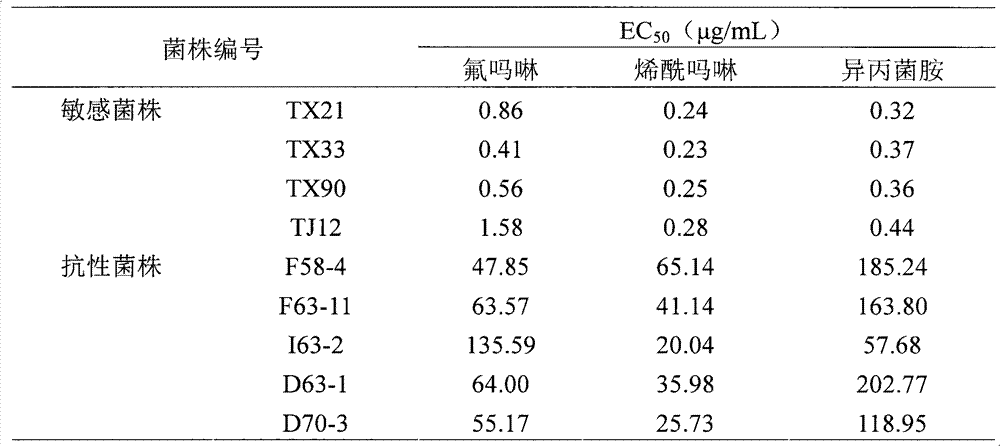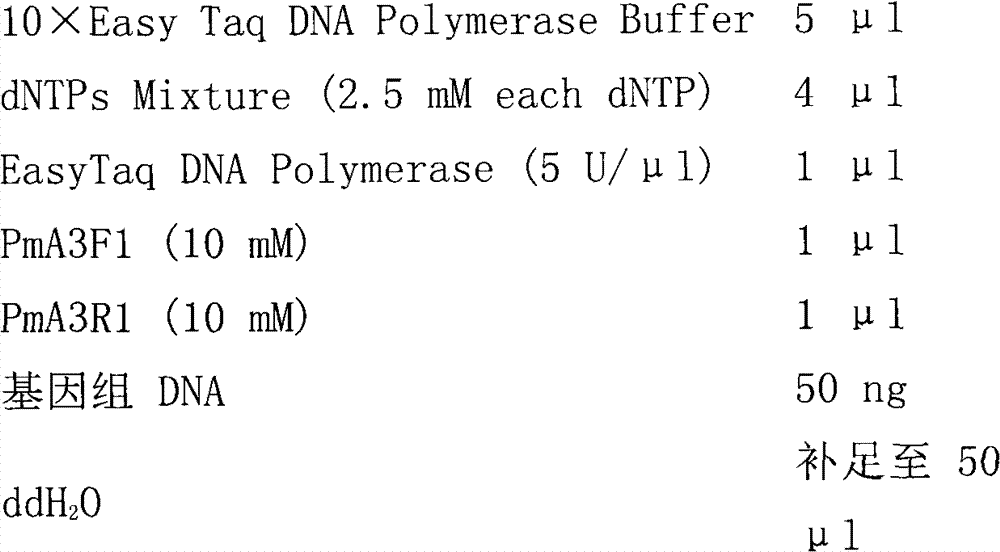Method for rapidly identifying resistance of phytophthora melonis to CAA bactericides and special primer
A drug-resistant and melon technology, applied in the field of molecular biology, can solve the problems of large workload, long detection period, low detection sensitivity, etc., and achieve the effects of long period, guaranteed result reliability, and large workload.
- Summary
- Abstract
- Description
- Claims
- Application Information
AI Technical Summary
Problems solved by technology
Method used
Image
Examples
Embodiment 1
[0030] Embodiment 1, Phytophthora cucurbitus is to the sensitivity determination of CAA fungicides flumorph, dimethomorph and iprocarbam
[0031] Five Phytophthora melonii resistant strains, the strain numbers are F58-4, I63-2, D63-1, F63-11 and D70-3; four Phytophthora melonii sensitive strains, the strain numbers are TX21, TX33 , TJ90 and TJ12.
[0032] Baiyun bean culture medium: 60g of Baiyun bean powder, 7g of agar powder, distilled water to 1L, sterilized by moist heat at 121°C for 20 minutes.
[0033] 1. The experimental steps are as follows:
[0034] 1) flumorph, dimethomorph and iprocarbam were respectively prepared with methanol for 10 5 μg / ml stock solution. For the sensitivity determination of four strains of Phytophthora cucurbitus sensitive strains, flumorph was diluted stepwise to 500 μg / mL, 700 μg / mL, 900 μg / mL, 1.00×10 3 μg / mL, 1.25×10 3 μg / mL, 1.50×10 3 μg / mL concentration gradient, dimethomorph was diluted to 100μg / mL, 150μg / mL, 200μg / mL, 250μg / mL, 300...
Embodiment 2
[0042] Embodiment 2, discovery of CesA3 gene and CesA3 protein mutation site in Phytophthora meloni
[0043] 1. Strains: The resistant strain is F58-4, and the sensitive strain is TX21.
[0044] 2. Method:
[0045] 1) Strain cultivation: culture Phytophthora melonii at 28°C with Baiyun bean culture medium (60g of Baiyun bean powder, 7g of agar powder, distilled water to 1L, 121°C moist heat sterilization for later use). The pre-cultured Phytophthora meloniformis was inoculated on the white cloud bean medium covered with cellophane, cultured in the dark at 28°C for 5 days, the mycelia were collected, frozen in liquid nitrogen and stored at -80°C for genomic DNA extraction.
[0046] 2) Genomic DNA of resistant strains and sensitive strains were extracted respectively.
[0047] 3) PCR amplification of cellulose synthase CesA3 gene
[0048] Primers: PmA3F1 (5'-TCTCGTGTCGGACGGACCAA-3') and PmA3R1 (5'-TCTGCATGTCCAGCCTTCC-3');
[0049] The PCR reaction system is as follows:
[0...
Embodiment 3
[0060] Embodiment 3, the method for detecting mutation site in Phytophthora cucurbita
[0061] 1. Primer design
[0062] The bacterial strain is the bacterial strain used in Example 1.
[0063] Primers are listed in Table 2.
[0064] Table 2. Primers used in PCR detection of Phytophthora cucurbitus strains resistant to CAA fungicides
[0065]
Primers
Sequence(5'-3')
PMF
ATCTACGCTCGCGGTACCAAG (Sequence 1)
PMR1109A
CGAACACCACGATGTACACCAG (Sequence 2)
PMR1109B
CGAACACCACGATGTACACCTG (Sequence 3)
PMR1109C
CGAACACCACGATGTACACCCG (sequence 4)
PMR1109D
CGAACACCACGATGTACACCGG (Sequence 5)
[0066] The PCR reaction system is as follows:
[0067] 50-μl PCR system:
[0068]
[0069] The PCR reaction conditions are as follows:
[0070]
[0071] The result is as figure 1 As shown in A. The results showed that: when the annealing temperature was 68.5°C, the primer pair PMF and PMR1109B could ...
PUM
 Login to View More
Login to View More Abstract
Description
Claims
Application Information
 Login to View More
Login to View More - R&D
- Intellectual Property
- Life Sciences
- Materials
- Tech Scout
- Unparalleled Data Quality
- Higher Quality Content
- 60% Fewer Hallucinations
Browse by: Latest US Patents, China's latest patents, Technical Efficacy Thesaurus, Application Domain, Technology Topic, Popular Technical Reports.
© 2025 PatSnap. All rights reserved.Legal|Privacy policy|Modern Slavery Act Transparency Statement|Sitemap|About US| Contact US: help@patsnap.com



